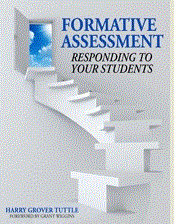As I look at articles, blogs, and conference sessions, I see titles like
Formative Assessment Through Clickers
Formative Assessment Through Cell phones
Formative Assessment Through the Class Blogs/Wikis
Formative Assessment Through Online Quizzes
Formative Assessment Through Twitter
Formative Assessment Through Flickr
These people are generally using Web 2.0 tools to monitor students, the first stage of formative assessment. They collect information about where the students are academically.
However, formative assessment moves from the monitor stage to the diagnosis stage. How does the students’ present status compare to the desired learning goal? If there are learning gaps, what strategies will help the students overcome those gaps?
If teachers or Web 2.0 programs do not offer improvement strategies based on the students’ specific learning gaps, then formative assessment does not occur. Formative Assessment is much more than just seeing how many questions the students can answer; it helps students to improve through providing new strategies for learning.
For example, if students take an online quiz about a certain learning goal, what happens next? Do the teachers diagnosis the results to see how individuals do on each item? Do the teachers determine which minor goals the students have yet to learn? Do the teachers determine which strategies will best help each student? Do the teachers give formative feedback to each student? Do the teachers build in class time for the students to practice their new formative strategy? Do the teachers re-assess the learning?
Do you use Web 2.0 tools to go beyond the monitoring of students to a full formative assessment?
My book, Formative Assessment: Responding to Your Students, is available through Eye on Education.
Also, my book, Successful Student Writing Through Formative Assessment, is available through Eye on Education.



